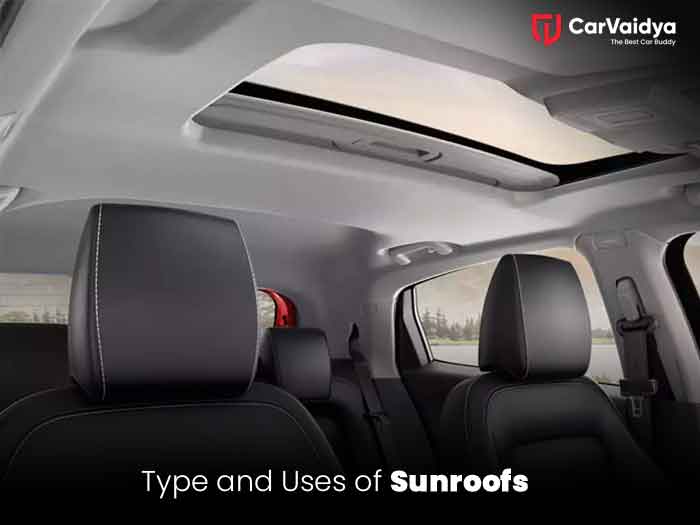Sunroofs have become a popular feature in modern vehicles, providing a unique driving experience by allowing natural light and fresh air to enter the cabin. These automotive roof openings come in various types, each offering distinct advantages and features. In this article, we will explore the different types of sunroofs and delve into their diverse applications.
Pop-up Sunroofs
One of the simplest and most cost-effective sunroof designs is the pop-up sunroof. This type is manually operated and typically tilts open to allow fresh air into the vehicle. Pop-up sunroofs are often found in older models and are a popular choice for those looking for a basic sunroof option without the complexity of motorized systems.
Inbuilt Sunroofs
Inbuilt sunroofs, also known as spoiler sunroofs, are seamlessly integrated into the vehicle's roof. They can be manually operated or powered, sliding open to create a larger opening than pop-up sunroofs. Inbuilt sunroofs are a common factory-installed option in many modern vehicles, offering a sleek and integrated appearance.
Folding Sunroofs
Folding sunroofs, sometimes referred to as ragtops, are characterized by their fabric or vinyl material. They can be either manually or electrically operated and are designed to retract and fold into a storage compartment, similar to a convertible top. This type provides a unique and open-air driving experience, combining elements of convertible and sunroof technologies.
Panoramic Sunroofs
Panoramic sunroofs are a popular choice for those seeking a more immersive experience. These sunroofs span a large portion of the vehicle's roof, offering an expansive view of the sky. They can be fixed or have a sliding feature, allowing users to control the amount of light and air entering the cabin. Panoramic sunroofs have gained popularity in luxury vehicles, providing a sense of openness and spaciousness to the interior.
Top-mount Sunroofs
Top-mount sunroofs are installed on the top surface of a vehicle's roof, similar to inbuilt sunroofs but with a distinctive design. They often feature a sleek and aerodynamic appearance. Top-mount sunroofs can be manually or electrically operated, offering a customizable level of openness to suit the driver's preference.
Solar Sunroofs
In the era of sustainable technology, solar sunroofs have emerged as a forward-thinking option. These sunroofs incorporate solar panels into their design, allowing the vehicle to harness solar energy for various purposes. While not as widespread as other types, solar sunroofs contribute to eco-friendly driving by providing an alternative source of power for auxiliary systems.
Applications of Sunroofs
Sunroofs serve not only aesthetic purposes but also offer practical benefits, enhancing the overall driving experience. Here are some of the key applications of sunroofs.
Natural Light and Ventilation
Sunroofs allow natural light to enter the vehicle, creating a brighter and more inviting interior.
They provide an additional source of ventilation, reducing the need for air conditioning and enhancing air circulation.
Aesthetic Appeal
Sunroofs add a touch of luxury and sophistication to a vehicle's design, contributing to its overall aesthetic appeal.
Panoramic sunroofs, in particular, create a sense of openness and spaciousness, making the interior more visually appealing.
Open-air Driving Experience
Folding and panoramic sunroofs provide an open-air driving experience, allowing drivers and passengers to enjoy the sights and sounds of the outdoors.
This feature is especially popular in warmer climates, offering an alternative to convertible cars.
Increased Resale Value
Vehicles equipped with sunroofs often have a higher resale value, as they are perceived as more desirable and luxurious.
The presence of a sunroof can be a selling point for used cars, attracting buyers who appreciate the added features.
Solar Energy Integration
Solar sunroofs contribute to the growing trend of sustainable driving by harnessing solar energy.
The captured solar power can be used to charge the vehicle's battery or power auxiliary systems, reducing reliance on traditional energy sources.
Conclusion
In conclusion, sunroofs come in a variety of types, each offering a unique driving experience. From the simplicity of pop-up sunroofs to the cutting-edge technology of solar sunroofs, these features enhance the overall appeal and functionality of vehicles. Whether for aesthetic reasons, increased resale value, or a desire for an open-air driving experience, sunroofs continue to be a sought-after option in the automotive industry. As technology advances and environmental consciousness grows, we can expect to see further innovations in sunroof design and functionality in the years to come.
You Can Read Some Other Articles
Enhancing your driving experience: installing a sunroof in your car
Essential tips to prevent engine seizurein you car
Increasing the lifespan of your car’s clutch

